Related Research Articles
Rex Applegate was an American military officer who worked for the Office of Strategic Services, where he trained Allied special forces personnel in close-quarters combat during World War II. He held the rank of colonel.
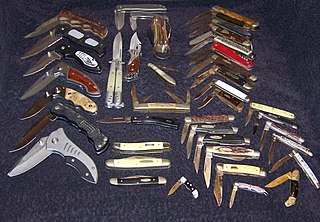
A pocketknife is a knife with one or more blades that fold into the handle. They are also known as jackknives (jack-knife), folding knives, EDC knife, or may be referred to as a penknife, though a penknife may also be a specific kind of pocketknife. Blade lengths typically range from 5 to 15 centimetres. Some pocketknives have multiple tools in addition to one or more blades.

A trench knife is a combat knife designed to kill or incapacitate an enemy at close quarters, such as in a trench or other confined area. It was developed as a close combat weapon for soldiers attacking enemy trenches during the First World War. An example of a World War I trench knife is the German Army's Nahkampfmesser.

The SOG Knife was designed for, and issued to, covert Studies and Observations Group personnel during the Vietnam War. It was unmarked and supposedly untraceable to country of origin or manufacture in order to maintain plausible deniability of covert operators in the event of their death or capture.

Gerber Legendary Blades is an American maker of knives, multitools, and other tools for outdoors and military headquartered in Portland, Oregon. Gerber is owned by the Finnish outdoors products company Fiskars. Gerber was established in 1939 by Pete Gerber.
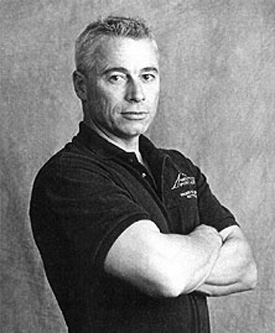
Ernest R. Emerson is an American custom knifemaker, martial artist, and edged-weapons expert. Originally an engineer and machinist in the aerospace industry, Emerson became a knifemaker by producing knives for a martial arts class and making art knives early in his knifemaking career. In the 1980s he became better known for his combat knives and popularizing a style of knife known as the Tactical-folder.

A combat knife is a fighting knife designed solely for military use and primarily intended for hand-to-hand or close combat fighting.
The Gerber Mark II is a fighting knife manufactured by Gerber Legendary Blades from 1966 to 2000, with an additional limited run of 1500 in 2002, and full production resuming as of July 2008. It was designed by retired United States Army Captain, Clarence A. “Bud” Holzmann, who based the pattern on a Roman Mainz Gladius.

The Fairbairn–Sykes fighting knife is a double-edged fighting knife resembling a dagger or poignard with a foil grip. It was developed by William Ewart Fairbairn and Eric Anthony Sykes in Shanghai based on ideas that the two men had while serving on the Shanghai Municipal Police in China before World War II.
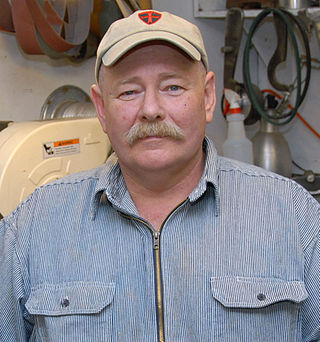
William Harsey Jr. is an American knifemaker and designer who works with several knife companies, including Gerber Legendary Blades, Lone Wolf Knives, Spartan Blades, Ruger/CRKT, Fantoni, and Chris Reeve Knives.
Kershaw Knives designs, sources and manufactures a wide range of knives, including pocketknives, sporting knives, and kitchen cutlery. Kershaw is a brand of Kai USA Ltd., a member of the KAI Group, headquartered in Tualatin, Oregon, United States.

SOG Specialty Knives, Inc. is an American knife and tool manufacturing company famous for their reproduction SOG Knife from the Vietnam era.
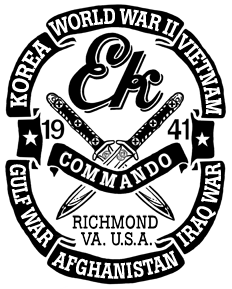
Ek Commando Knife Co. or Ek Knives is an American combat knife brand produced by several different companies since the original founded by John Ek in 1941. In May 2014 the Ek brand was purchased by Ka-Bar which began selling its versions of Ek knife designs in 2015. Although not officially issued gear, Ek Knives have seen use by US forces in six major conflicts: World War II, the Korean War, the Vietnam War, the Gulf War, Afghanistan, and the Iraq War. Ek Knives manufactures Bowie-style blades, daggers, and a Fairbairn-Sykes MkII. President Franklin Delano Roosevelt, Clark Gable, and General George S. Patton have been identified as Ek knife owners.
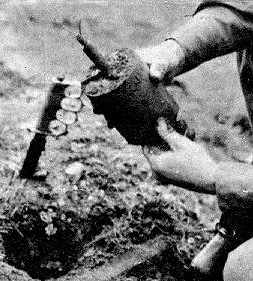
The Mark I trench knife is an American trench knife designed by officers of the American Expeditionary Force (AEF) for use in World War I. It has a 6.75 in (17.1 cm) double-edged dagger blade useful for both thrusting and slashing strokes, unlike previous U.S. trench knives such as the M1917 and M1918. The handle is made of cast bronze and uses a conical steel nut to hold the blade in place. The Mark I's blade was blued with a black oxide finish, the bronze handle was chemically blackened, with cast spikes on the bow of each knuckle. The spikes were intended to prevent an opponent from grabbing the knife hand, as well as to provide a more concentrated striking surface when employed in hand-to-hand combat.
Emerson Knives, Inc. is an American company that produces knives and related products. It was founded in 1996 by custom knifemaker Ernest Emerson in an effort to mass-produce his folding knife designs for the U.S. Military and collector markets.
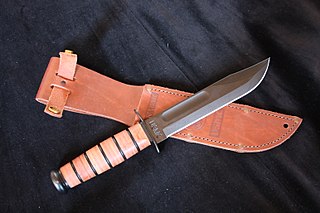
Ka-Bar is the contemporary popular name for the combat knife first adopted by the United States Marine Corps in November 1942 as the 1219C2 combat knife, and subsequently adopted by the United States Navy as the U.S. Navy utility knife, Mark 2. Ka-Bar is the name of a related knife manufacturing company, Ka-Bar Knives., Inc., of Olean, New York, a subsidiary of the Cutco Corporation.

Al Mar Knives is a production knife company headquartered in Tualatin, Oregon, United States. Al Mar Knives was established in 1979 by Al Mar, and has a reputation for making tactical knives of innovative design. While headquartered in the United States, Al Mar knives were made in Seki City of Japan from 1979 to 2019.
Bo Randall was an American knifemaker who founded Randall Made Knives in Orlando, Florida.
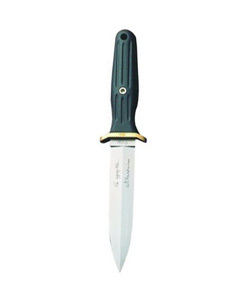
The Applegate–Fairbairn fighting knife is a combat knife designed by Colonel Rex Applegate and William E. Fairbairn as a version of the Fairbairn–Sykes fighting knife. The blade has a similar double-edged dagger profile, but is wider and more durable. It features a different handle, made most commonly of Lexan plastic with adjustable lead weights which can change the knife's balance-point. Later models and some custom variants included weights made from pure Teflon, tungsten, stainless steel and aluminum. The blade profile was also changed from a V-grind to a convex, or "appleseed" profile. While this changed the overall effectiveness of the blade to puncture, cut and slice, it does not lend itself to be field sharpened by an inexperienced user. The current production model made by Böker in Solingen, Germany, uses a fiberglass reinforced delrin handle which solves the issues with earlier models where the handle would crack if exposed to heat.

A fighting knife has a blade designed to most effectively inflict injury in close-quarters physical confrontations. The combat knife and the trench knife are examples of military fighting knives.
References
- ↑ Pacella, Gerard (2002), 100 Legendary Knives, Iola, USA, Krause Publications, 145. ISBN 0-87349-417-2
- 1 2 3 4 Trzaska, Frank (2001), Military Knives: A Reference Book, California: Knife World Publications, p. 256, ISBN 0-940362-18-X